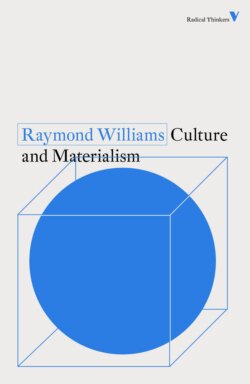Читать книгу Culture and Materialism - Raymond Williams - Страница 18
На сайте Литреса книга снята с продажи.
Superstructure: Qualifications and Amendments
ОглавлениеThe term of relationship is then the first thing that we have to examine in this proposition, but we have to do this by going on to look at the related terms themselves. ‘Superstructure’ (Überbau) has had most attention. In common usage, after Marx, it acquired a main sense of a unitary ‘area’ within which all cultural and ideological activities could be placed. But already in Marx himself, in the later correspondence of Engels, and at many points in the subsequent Marxist tradition, qualifications were made about the determined character of certain superstructural activities. The first kind of qualification had to do with delays in time, with complications, and with certain indirect or relatively distant relationships. The simplest notion of a superstructure, which is still by no means entirely abandoned, had been the reflection, the imitation or the reproduction of the reality of the base in the superstructure in a more or less direct way. Positivist notions of reflection and reproduction of course directly supported this. But since in many real cultural activities this relationship cannot be found, or cannot be found without effort or even violence to the material or practice being studied, the notion was introduced of delays in time, the famous lags; of various technical complications; and of indirectness, in which certain kinds of activity in the cultural sphere—philosophy, for example—were situated at a greater distance from the primary economic activities. That was the first stage of qualification of the notion of superstructure: in effect, an operational qualification. The second stage was related but more fundamental, in that the process of the relationship itself was more substantially looked at. This was the kind of reconsideration which gave rise to the modern notion of ‘mediation’, in which something more than simple reflection or reproduction—indeed something radically different from either reflection or reproduction—actively occurs. In the later twentieth century there is the notion of ‘homologous structures’, where there may be no direct or easily apparent similarity, and certainly nothing like reflection or reproduction, between the superstructural process and the reality of the base, but in which there is an essential homology or correspondence of structures, which can be discovered by analysis. This is not the same notion as ‘mediation’, but it is the same kind of amendment in that the relationship between the base and the superstructure is not supposed to be direct, nor simply operationally subject to lags and complications and indirectnesses, but that of its nature it is not direct reproduction.
These qualifications and amendments are important. But it seems to me that what has not been looked at with equal care is the received notion of the ‘base’ (Basis, Grundlage). And indeed I would argue that the base is the more important concept to look at if we are to understand the realities of cultural process. In many uses of the proposition of base and superstructure, as a matter of verbal habit, ‘the base’ has come to be considered virtually as an object, or in less crude cases, it has been considered in essentially uniform and usually static ways. ‘The base’ is the real social existence of man. ‘The base’ is the real relations of production corresponding to a stage of development of the material productive forces. ‘The base’ is a mode of production at a particular stage of its development. We make and repeat propositions of this kind, but the usage is then very different from Marx’s emphasis on productive activities, in particular structural relations, constituting the foundation of all other activities. For while a particular stage of the development of production can be discovered and made precise by analysis, it is never in practice either uniform or static. It is indeed one of the central propositions of Marx’s sense of history that there are deep contradictions in the relationships of production and in the consequent social relationships. There is therefore the continual possibility of the dynamic variation of these forces. Moreovr, when these forces are considered, as Marx always considers them, as the specific activities and relationships of real men, they mean something very much more active, more complicated and more contradictory than the developed metaphorical notion of ‘the base’ could possibly allow us to realize.
